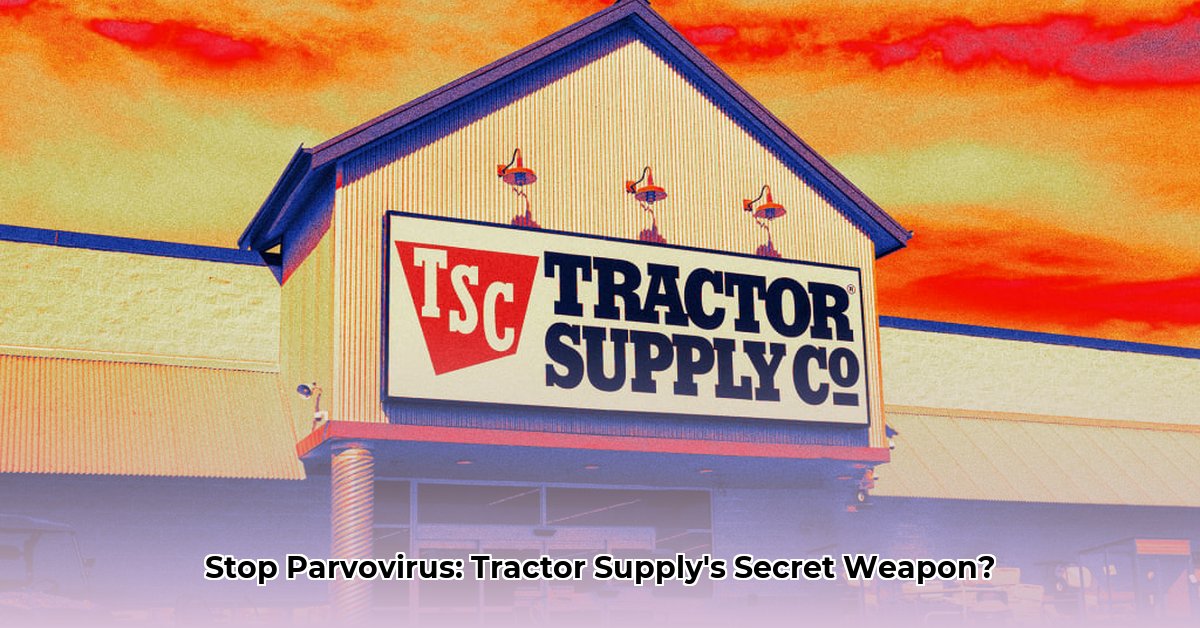
Understanding Parvovirus and Yard Disinfection
Canine parvovirus is a highly contagious and potentially fatal disease. Effective disinfection of contaminated areas is crucial to prevent its spread. This guide details the use of Tractor Supply's Rescue Disinfectant Concentrate for yard disinfection, focusing on safe and effective application. We'll explore its active ingredient, application methods, safety protocols, and limitations. For additional disinfecting options, check out other disinfectants.
Rescue Disinfectant Concentrate: A Closer Look
Rescue Disinfectant Concentrate utilizes accelerated hydrogen peroxide (AHP) as its active ingredient. AHP is a powerful oxidizer that breaks down organic material, including parvovirus, into water and oxygen. This makes it a relatively environmentally friendly option compared to harsher disinfectants. However, it's crucial to understand that while AHP is effective against a broad spectrum of pathogens, independent scientific verification of its specific efficacy against parvovirus is still pending.
Preparing Your Yard for Treatment
Before applying Rescue Disinfectant Concentrate, thorough pre-cleaning is essential. Parvovirus can persist in organic matter, hindering the disinfectant's effectiveness. Remove all visible feces, vomit, and debris. Pressure washing or scrubbing with detergent will maximize the impact of the disinfectant. Think of it like this: you wouldn't try to clean a greasy dish without first washing away the grease; the same principle applies here.
Step-by-Step Application Instructions
Follow these steps precisely for optimal results:
Dilution: Carefully follow the dilution instructions printed on the Rescue Concentrate label. Incorrect dilution significantly reduces efficacy. Use accurate measuring tools.
Protective Gear: Always wear gloves, eye protection, and a mask when handling and applying the concentrate. Skin and eye irritation are possible.
Spray Application: Use a clean garden sprayer to apply the diluted solution evenly over the pre-cleaned area. Maintaining a consistent distance will ensure uniform coverage. Avoid over-saturation; it won't improve results and wastes product.
Contact Time: Allow the treated area to remain wet for the time specified on the product label (typically 5-10 minutes). This contact time is essential for effective virus inactivation.
Air Drying: Allow the area to air dry completely. Do not rinse.
Safety Precautions: Handling with Care
Proper Ventilation: Work in a well-ventilated area or ensure good airflow if indoors to minimize inhalation of fumes.
Storage: Store Rescue Disinfectant Concentrate out of reach of children and pets, in its original container, away from incompatible materials.
Disposal: Dispose of leftover solution and containers responsibly, following local regulations. Never pour down the drain.
Material Compatibility: Test the solution on an inconspicuous area first to avoid damage to sensitive surfaces. Marble, brass, and copper are particularly susceptible to discoloration or damage.
Maximizing Efficacy: Factors to Consider
Several factors influence the effectiveness of Rescue Disinfectant Concentrate:
Thorough Pre-Cleaning: This step is absolutely critical. Removing organic matter allows the disinfectant to directly contact the virus.
Exact Dilution: Use precise measurements to achieve the correct concentration for optimal results. Improper dilution drastically reduces efficacy.
Environmental Factors: Temperature and humidity can affect the disinfectant's performance. Higher temperatures generally enhance effectiveness.
Dr. Emily Carter, DVM, Veterinary Epidemiologist, University of California, Davis, emphasizes, "While Rescue Disinfectant Concentrate shows potential, pre-cleaning is absolutely non-negotiable. Think of it like using a powerful cleaner on a lightly soiled surface – the cleaner will eventually work, but it takes longer and it doesn't do as stellar of a job."
Troubleshooting Potential Issues
Uneven Disinfection: Re-evaluate your application method. Ensure even distribution during spraying and consider retreatment of any missed areas.
Ineffective Disinfection: Check for sufficient contact time and proper dilution. Thorough pre-cleaning is also paramount.
Material Damage: Refer to the product label's material compatibility guide. Always conduct a test application on an inconspicuous area before treating the broader area.
Conclusion: Responsible Use for Effective Disinfection
Rescue Disinfectant Concentrate offers a powerful tool for controlling parvovirus in your yard. However, its effectiveness depends heavily on proper application, thorough pre-cleaning, and careful adherence to safety guidelines. Always refer to the product label for the most up-to-date instructions. Remember, this is one tool in your arsenal for controlling this serious disease. Regularly assess your yard hygiene measures as an overall strategy.